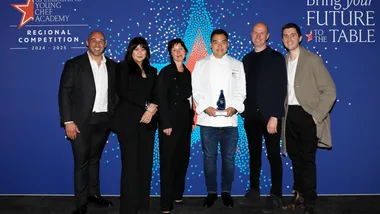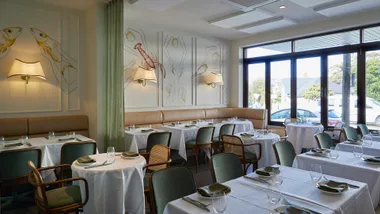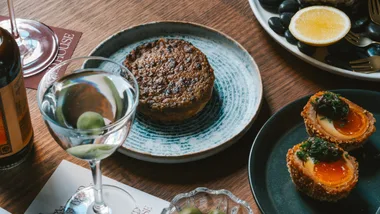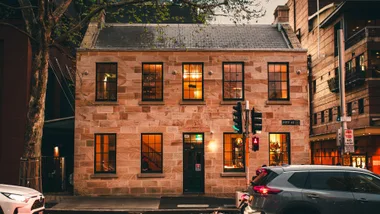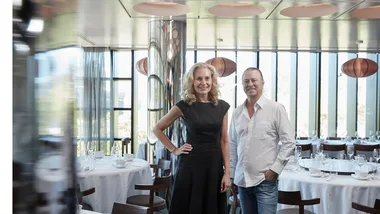In 1845, exhausted, starving and close to death, the explorer Charles Sturt and his party encountered a village of around 400 Aboriginal people in a dry floodplain in the South Australian desert. In his journal, Sturt wrote that the villagers “treated us with genuine hospitality”, offering the desperate white strangers “large troughs of water… some roasted ducks, and some cake”. Roast duck and cake. Just imagine how glorious that must have tasted to those famished men.
Author Bruce Pascoe loves this story because it invites us to think differently about Aboriginal people and Australian history: this is not a portrayal of nomads subsisting in a harsh environment, but a settled community grinding flour and baking cake.
It’s one of many similar insights Pascoe has gleaned from the journals and diaries of explorers and early settlers, and gathered in his book, Dark Emu, Black Seeds: Agriculture or Accident? As Charles Sturt, Thomas Mitchell and others rode across deserts and through the bush of inland Australia in the early 19th century, they recorded countless examples of women cultivating vast fields of yellow-flower yam daisies; people growing grain; men fishing in elaborate and ancient stone aquaculture systems.
As Pascoe writes in Dark Emu, these accounts challenge our deep-seated preconception of Aboriginal people as “mere hunter-gatherers… simply wandering from plant to plant, kangaroo to kangaroo in hapless opportunism” – a preconception that, he reminds us, “has been used as a political tool to justify dispossession”.
Instead, he says, these forgotten accounts encourage us to think of Aboriginal people as farmers: sowing, harvesting and storing seed on a vast scale; cultivating crops; building permanent villages; trading preserved surpluses of food over huge distances.
And the author doesn’t just want us to learn about this hidden history. He also wants us to eat the food that Sturt and others saw being harvested: he wants Australia to embrace Aboriginal agriculture.
Late last year, Pascoe – who has Bunurong, Tasmanian and Yuin Indigenous heritage – in collaboration with Aboriginal groups on the New South Wales South Coast and in East Gippsland, launched a Pozible crowd-funding campaign to “support the recovery of our traditional food plants”.
Called Gurandgi Munjie, this group had already started growing indigenous yams, grains, vegetables, fruits and herbs on a voluntary basis, and the group turned to Pozible for help to expand and commercialise the business “to provide permanent employment and training for young Aboriginal people and to supply healthy products to Australia from plants adapted to Australian conditions”. The campaign met and exceeded its target. The next phase of the Gurandgi Munjie project is now well under way.
“I was pretty confident we would get there,” Pascoe says. “But to receive more funding than we asked for was fantastic. It has given the group confidence. Our people were happy that the broader community showed so much interest in what we were doing. Aboriginal culture is obviously accepted a bit more widely these days than it used to be.”
One of the first crops the Gurandgi Munjie group focused on was the murnong, or yam daisy. A dandelion-like plant with a bright yellow flower and energy-packed tuber, murnong was a staple food for Aboriginal people across south-eastern Australia before the arrival of Europeans; the explorers describe plains of the perennial being tended by Aboriginal women. It was also, tragically, one of the first plants to be almost entirely wiped out by the settlers’ sheep within just a couple of years of their arrival.
I visited Pascoe and his partner, Lyn Harwood, at their Gipsy Point home in East Gippsland in spring to see the yam daisies growing. Local horticulturist Annette Peisley has been working on the cultivation trials, and when we visited her property, she gently teased a couple of young plants from the soil.
“We’re working with two kinds of yam daisy here,” she told me. “Microseris lanceolata has a tuber the size of your little finger, tastes sweeter, could be used as a summer salad vegetable, uncooked – that’s the feature of those fellows. And the other one is Microseris scapigera: they have multiple tubers, and I find them bitter as buggery raw, so they need to be roasted.”
I bite into the Mlanceolata root: it’s crunchy, like a radish, with a flavour somewhere between a sweet new potato and a juicy, milky lettuce stalk. The Mscapigera is denser, and a little more fibrous, with a deep, earthy flavour a little like Jerusalem artichoke.
Pascoe describes how well the yam daisy tubers take to cooking: how they work well as a vegetable in a curry, losing bitterness and retaining sweetness, and how, when roasted, they exude a rich juice that the Wathaurong people of the Geelong area call “minne”.
“The yam daisy has been the number-one priority,” he says. “We’ve put so much effort and scientific work into it over the last four or five years, and every month we make such a big advance. It gives us real heart that we can get good results; in a year’s time we reckon we’ll be selling yam daisy through whole-food markets and into restaurants, in New South Wales at first, and then further afield.”
The other exciting development is the revival of indigenous grains such as native millet and kangaroo grass – grains the early white explorers so often witnessed being harvested and ground into flour and baked across Australia.
As Pascoe points out, “these grains grow profusely – they don’t need fertiliser, they don’t need water. What a boon to our agricultural industry if they turn out to be a commercially viable food plant. The stunning thing is that in more than two centuries of Australian history, no one’s bothered to find out.”
Until now. At Lake Mungo in October last year, local Barkinji, Latchi Latchi and Mutti Mutti people baked bread from native millet (Panicum decompositum). “When the loaves came out of the oven the tears flowed,” Pascoe wrote for the Pozible campaign. “It was 200 years since this bread had been baked. It was a threshold moment.”
And, for a welcome breakfast at the Rootstock wine and food festival in Sydney last November, chef Pasi Petänen baked loaves of rye bread incorporating Panicum decompositum flour supplied by the Gurandgi Munjie group. The excitement in the room was palpable as people tore open the dense flat brown loaves and savoured the sweet nutty flavours – flavours that Mitchell and Sturt first tasted in the 1830s and ’40s and that Aboriginal people have been enjoying for millennia.
“Everyone’s excited by these grains,” says Pascoe. “With the rise in interest in all sorts of artisan breads these days, we reckon there’ll be some serious commercial interest in our flours.”
The crops that the Gurandgi Munjie group are reviving are staples – everyday foods that were once widely grown and eaten in those parts of the country where most Australians now live, rather than exotic novelty “bush tucker” ingredients from the obscure outback that some high-end chefs in Sydney or Melbourne might incorporate into their cooking.
As Pascoe writes in Dark Emu, this is a subtle but important shift in thinking: “Schoolchildren are [still] taught that witchetty grubs were a major food source [for Aboriginal people],” he says, “almost as if there’s a deliberate attempt by educationalists to emphasise the gross and primitive.” Instead, he says, “If we look at the evidence presented to us by the explorers and explain to our children that Aboriginal people did build houses, did build dams, did sow, irrigate and till the land, did alter the course of rivers, did sew their clothes and did construct a system of government that generated peace and prosperity, then it is likely we will admire and love our land all the more. Love and admiration are not sufficient in themselves, but they are the foundation of a more productive interaction with the continent.”
Pascoe likes to tell the story of grindstones found at Cuddie Springs in northern New South Wales that have been dated as being around 30,000 years old – evidence that Aboriginal people were grinding seeds some 15,000 years before the ancient Egyptians started using flour to bake bread.
“Which means, of course, that we’re the world’s first bakers,” he says, smiling. “My hope is that Australians will learn to feel proud about this – that, when they go overseas, they won’t just talk about Vegemite, or about their cricket team, but they’ll say, ‘hey, we’re the country that invented bread’.”
Purchase a copy of Dark Emu at magabala.com/contemporary-non-fiction/dark-emu.html
.jpg?fit=900%2C1051)
